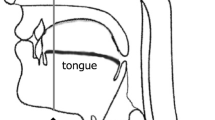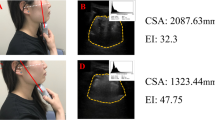Abstract
The tongue plays a key role in oropharyngeal swallowing. It has been reported that maximum isometric tongue pressure decreases with age. The risk for dysphagia resulting from low tongue strength remains unclear. This study was designed to reveal the relationship between tongue pressure and clinical signs of dysphagic tongue movement and cough and to demonstrate the clinical value of tongue pressure measurement in the evaluation of swallowing function. One hundred forty-five institutionalized elderly in five nursing homes participated. Evaluation of physical activity with self-standing up capability and mental condition with Mini Mental Status Examination (MMSE) were recorded. Maximum tongue pressure was determined using a newly developed tongue pressure measurement device. Voluntary tongue movement and signs of dysphagic cough at mealtime were inspected and evaluated by one clinically experienced dentist and speech therapist. The relationship between level of tongue pressure and incidence of cough was evaluated using logistic regression analysis with physical and mental conditions as covariates. Tongue pressure as measured by the newly developed device was significantly related to the voluntary tongue movement and incidence of cough (p < 0.05). The results of this study suggest that tongue pressure measurement reflects clinical signs of dysphagic tongue movement and cough and that measurement of tongue pressure is useful for the bedside evaluation of swallowing.

Similar content being viewed by others
References
Yamaya M, Yanai M, Ohrui T, Arai H, Sasaki H: Interventions to prevent pneumonia among older adults. J Am Geriatr Soc 49:85–90, 2001
Hughes T: Neurology of swallowing and oral feeding disorders: assessment and management. J Neurol Neurosurg Psychiatry 74:iii48–iii52, 2003
Robbins J, Hamilton JW, Lof GL, Kempster G: Oropharyngeal swallowing in normal adults of different ages. Gastroenterology 103:823–829, 1992
Logemann JA, Pauloski BR, Rademaker AW, Colangelo LA, Kahrilas PJ, Smith CH: Temporal and biomechanical characteristics of oropharyngeal swallow in younger and older men. J Speech Lang Hear Res 43:1264–1274, 2000
Dodds WJ: The physiology of swallowing. Dysphagia 5:171–178, 1987
Shaker R, Cook IJS, Dodds WJ, Hogan WJ: Pressure-flow dynamics of the oral phase of swallowing. Dysphagia 3:79–84, 1988
Nagao K, Kitaoka N, Kawano F, Komoda J, Ichikawa T: Influence of changes in occlusal vertical dimension on tongue pressure to palate during swallowing. Prosthodont Res Pract 1:16–23, 2002
Miller JL, Watkin KL: The influence of bolus volume and viscosity on anterior lingual force during the oral stage of swallowing. Dysphagia 11:117–124, 1996
Tsuga K, Hayashi R, Sato Y, Akagawa Y: Handy measurement for tongue motion and coordination with laryngeal elevation at swallowing. J Oral Rehabil 30:985–989, 2003
Pouderoux P, Kahrilas PJ: Deglutitive tongue force modulation by volition, volume, and viscosity in humans. Gastroenterology 108:1418–1426, 1995
Crow HC, Ship JA: Tongue strength and endurance in different aged individuals. J Gerontol Ser A Biol Sci Med Sci 51:M247–M250, 1996
Robbins J, Levine R, Wood J, Roecker EB, Luschei E: Age effects on lingual pressure generation as a risk factor for dysphagia. J Gerontol Ser A Biol Sci Med Sci 50:M257–M262, 1995
Hayashi R, Tsuga K, Hosokawa R, Yoshida M, Sato Y, Akagawa Y: A novel handy probe for tongue pressure measurement. Int J Prosthodont. 15:385–388, 2002
Folstein MF, Folstein SE, McHugh PR: Mini-Mental State. A practical method for grading the cognitive state of patients for the clinician. J Psychiatr Res 12:189–198, 1975
Armellini D, von Fraunhofer JA: The shortened dental arch: a review of the literature. J Prosthet Dent 92:531–535, 2004
Lambert HC, Gisel EG, Groher ME, Wood-Dauphinee S: McGill Ingestive Skills Assessment (MISA): development and first field test of an evaluation of functional ingestive skills of elderly persons. Dysphagia 18:101–113, 2003
Mann G, Hankey GJ: Initial clinical and demographic predictors of swallowing impairment fallowing acute stroke. Dyspagia 16:208–215, 2001
Lazarus CL, Logemann JA, Pauloski BR, Rademaker AW, Larson CR, Mittal BB, et al.: Swallowing and tongue function following treatment for oral and oropharyngeal cancer. J Speech Lang Hear Res 43:1011–1023, 2000
Evans WJ: What is sarcopenia? J Gerontol Ser A Biol Sci Med Sci 50:5–8, 1995
Marcell TJ: Sarcopenia: causes, consequences, and preventions. J Gerontol Ser A Biol Sci Med Sci 58:M911–M916, 2003
Nicosia MA, Hind JA, Roecker EB, Carnes M, Doyle J, Dengel GA, et al.: Age effects on temporal evolution of isometric and swallowing pressure. J Gerontol Ser A Biol Sci Med Sci 55:M634–M640, 2000
Lazarus C, Logemann JA, Huang CF, Rademaker AW: Effects of two types of tongue strengthening exercises in young normals. Folia Phoniatr Logop 55:199–205, 2003
Logemann JA: The swallowing examination. In: Logemann JA (ed.) Evaluation and treatment of swallowing disorders, 2nd edn. Austin, TX: Pro-ed, 1998, pp 164–168
Nakazawa H, Sekizawa K, Ujiie Y, Sasaki H, Takishima T: Risk of aspiration pneumonia in the elderly. Chest 335:1228–1229, 1993
Author information
Authors and Affiliations
Corresponding author
Additional information
This study was supported by a grant-in-aid from the Ministry of Health, Labour and Welfare (tyoujyu-14-020).
Rights and permissions
About this article
Cite this article
Yoshida, M., Kikutani, T., Tsuga, K. et al. Decreased Tongue Pressure Reflects Symptom of Dysphagia. Dysphagia 21, 61–65 (2006). https://doi.org/10.1007/s00455-005-9011-6
Published:
Issue Date:
DOI: https://doi.org/10.1007/s00455-005-9011-6




